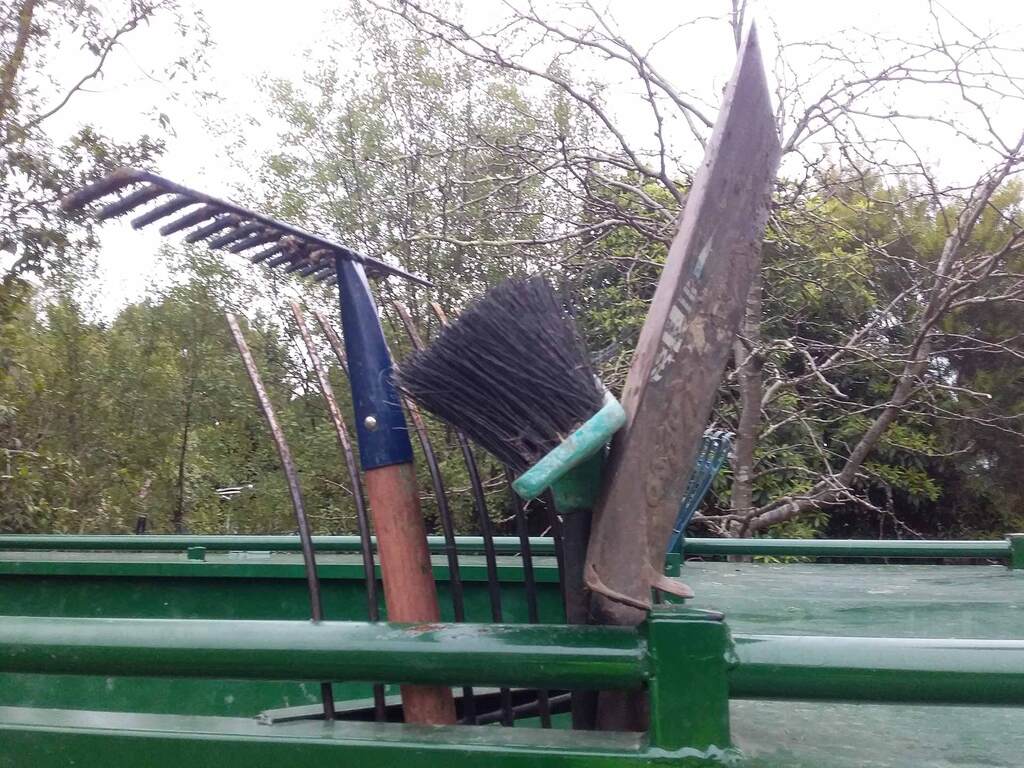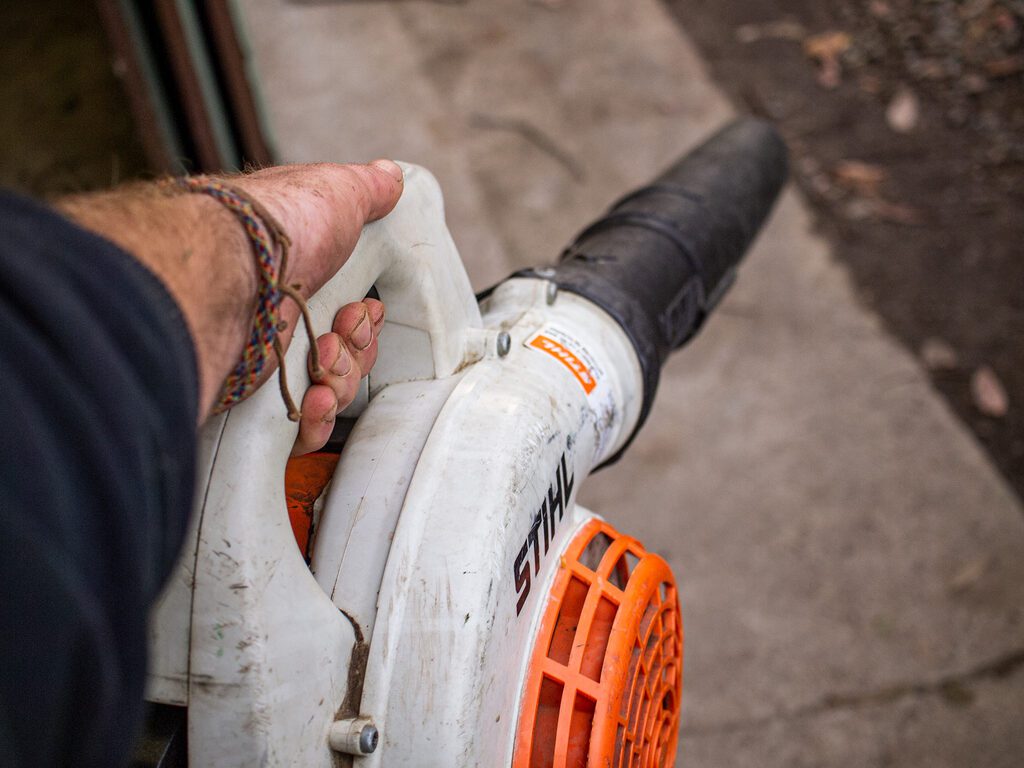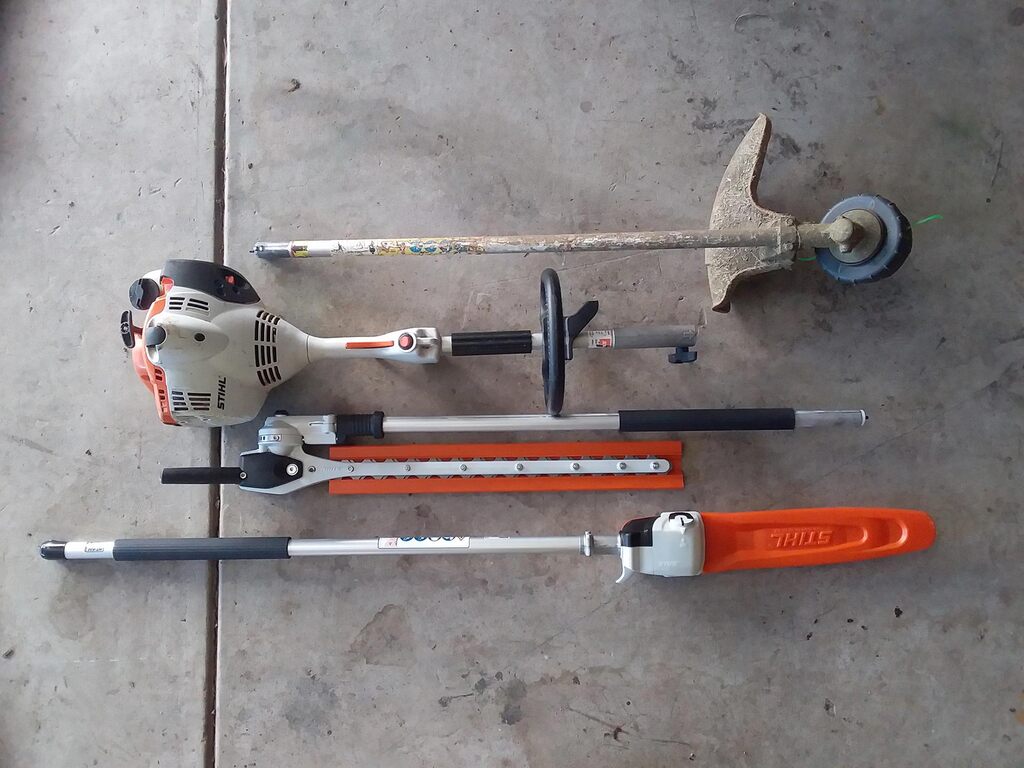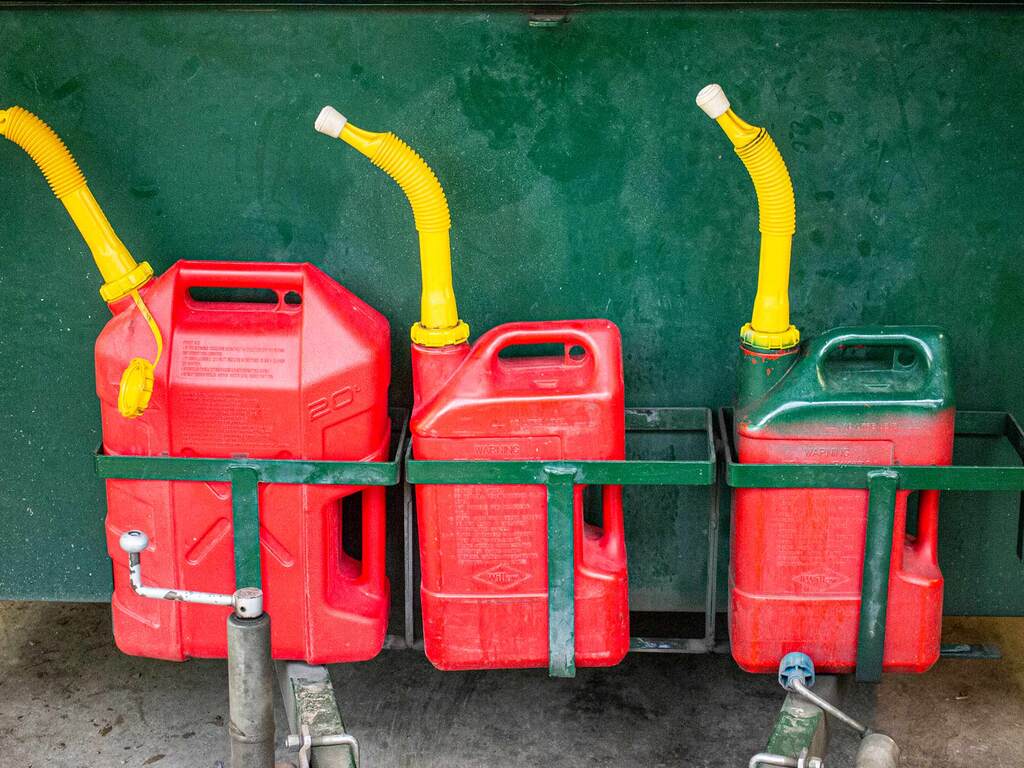
Gardening is such a wide topic and humans have used hundreds of tools to varying success throughout history. These days, you can fit everything you need to run a modern gardening business in a ute/van and trailer.
In this article is a pretty comprehensive list of the basics you’ll eventually need in the truck, but if you’re just starting out you might get a heart attack when you see it. Don’t worry, you can accumulate the equipment as you start to work your own way around your gardens.

Petrol tools in the trailer. Image via Plants Grow Here.
It’s recommended to specialise as a mowing business when you’re first starting in order to keep costs down, rather than buy too many of the tools all in one go. In fact, you can probably get away with a vehicle, a mulching mower, a whip, a blower as well as some basic hand tools and consumables.
Check out my blog on starting a mowing business without any money for inspiration; you can always branch out into offering other gardening services as you build up your equipment.
No Advertisements
Before we start, you should know that there are no ads on this page; all brand recommendations are made due to the fact that I’ve tried and recommend their products. They’re also brands that are regularly used by contractors around Australia.
Consumables & Non-Consumables
Some of the tools and equipment you’re going to be using will need to be replaced, and some of them have a longer life span than others. However, consumable items are differentiated because they are designed to be replaced.
A whipper snipper is a non-consumable piece of equipment but the trimming line, 2 stroke oil and petrol are consumable.
The List
-
PPE
-
Toolbox
-
Secateurs
-
Loppers
-
Shears
-
Hand Saw
-
Maddock
-
Shovels
-
Mulching Fork
-
Rakes
-
Mowers
-
Mower Blades
-
Mower Engine Oil
-
Blower
-
Combination Engine
-
Whipersnipper Attachment
-
Whip Heads
-
Trimming Line
-
Hedging Attachment
-
Small Hedger
-
Lanolin Spray
-
Pole Saw Attachment
-
Chainsaw
-
Chains
-
Chainsaw Bar & Chain Oil
-
Hose & Nozzle
-
Spray Packs
-
Chemicals
-
Fuel Jerries
-
2 Stroke
-
Ute/Van
-
Trailer
-
Tarps
-
Ropes
-
Grass Bags/Bins
-
Wheelbarrows
Personal Protective Equipment (PPE) includes safety glasses, work boots (steel cap), ear protection and sun protection, all of which are non-optional. Some PPE is optional, such as gloves when you’re mowing or pruning; personally I prefer not to wear gloves as I like to feel what I’m doing but I am forced to wear anti-vibration gloves because of long-term pain in my wrists.
You should start with a toolbox holding a basic set of tools including a couple of shifting spanners, a scrench (comes with whips & chainsaws), a couple of screwdrivers, a mallet, measuring tape and other basic tools.

A small toolbox fits in the back of the ute, along with a mallet, a scrench and a hand-weeding tool.
Eventually, you’re going to want to have a shed with a proper set of spanners, an air compressor, and an angle grinder but realistically some of the bigger ticket items are probably going to be accumulated over a period of years as you grow. You can always outsource sharpening of blades, etc. to your local mower shop.
Secateurs come in handy all the time. You can buy cheapies and continually replace them, but if you invest in a good pair of seccies they will last you a long time as long as you don’t lose them.
A pair of Felco Number 2s (around $90-$100) are a classic choice that will last a lifetime of being belted. They are expensive but they’re basically an heirloom.
I use cheap loppers and replace them about once a year. You might do well with an expensive pair but I haven’t tried any that I can personally recommend.
Some people like to use shears for hedging. Usually I’ll use the petrol hedger but if the blades are dull then I will grab the shears as they are normally sharp from less usage. They need to be nice and tight in order to work properly.
A hand saw comes in handy when you only have to cut one or two branches or when you’re doing delicate cutting work on branches that are too thick for the loppers.
You can use a maddock to break apart hard soils when digging out established plants or planting.
There are a couple of shovels you’ll need: a post hole shovel is narrow and sharp for digging holes, whereas a concreting shovel is good for picking up gravel as it’s wider and curved to hold material. A small trowel can be great for smaller jobs like planting seedlings and some people use them for pulling weeds though there are better little tools that disturb the soil less, as in the photo above with the toolbox.
Concreting shovels can be used for moving mulch, however the best tool in my opinion is a mulching fork. There is very little resistance which makes the job easier. The only downside is that mulch tends to get stuck to the teeth, so you need to loosen them off every now and then.
You’ll need at least two types of rake: a sturdy steel rake for moving soil, gravel, etc. and two or three plastic ones for taking up soft hedge trimmings etc. A soil spreader can be added to your kit if you plan on doing a lot of soft landscaping.

This trailer has spaces to store tools vertically. Image via Plants Grow Here.
You’ll need to make a decision about the sorts of mowers you’re working with. The three main types are mulching, catching and side throwing mowers. Briggs & Stratton, Rover and Honda are all good brands. Check out my article titled Whip Mow Blow & Go: How To Mow Like A Pro for more info on the three types of mower.

A mulching mower with a side throw attachment, via Plants Grow Here.
Mower blades that will wear down, requiring sharpening and eventually replacing. Mower oil is easy to overlook but must also be accounted for.
The two main types of blowers are backpack and hand-held variations, though there is also a blowing attachment for a combi engine. Stihl and Echo are good brands.

A Stihl petrol hand-held blower. Image via Plants Grow Here.
A combination engine (a.k.a. combi) is a whipper snipper engine that is able to also attach to other tools such as hedging and pole saw attachments. I personally love the Stihl combination setup.
The first attachment you’ll need is a whipper snipper. You’ll also need replacement plastic whipper heads and trimming line which are consumable.
The next attachment to get is a hedging one, designed for tall hedges but can be used for most smaller hedges. You can save up for a small hedger which is really a better tool for the smaller stuff. Lanolin spray is a consumable lubricant for the blades.
The third attachment you’ll need for the combi is a pole saw which you can use to cut taller branches or those on the ground. A more powerful hand-held chainsaw with a longer bar is better for thicker branches and trunks. Husqvarna and Stihl are both good chainsaw brands.

A stihl combination setup with a whip, pole hedger and pole saw. Image via Plants Grow Here.
You’ll need a spare sharp chain just in case you hit sand and blunten the first chain. Bar and chain oil is used to keep the system lubricated; never use your chainsaw without a full tank of chain oil.
If you decide to purchase a chainsaw or pole saw you have a duty of care to have yourself trained and certified in its use. It’s seriously easy to seriously maim or kill yourself and others with this type of tool.
A hose and nozzle come in handy now and then. You don’t need them until you do.
Keeping multiple spray packs is smart because you don’t want to mix your fertilisers, your herbicides and your pesticides. Use multiple sizes from backpacks to smaller handheld ones.
If you’re trained in chemical use you can store multiple different products to use in your spray packs. Make sure you follow all instructions on the labels; if you don’t understand the label that means you aren’t qualified to use the product. You can read more about herbicides and pesticides through some of my other blogs.
You’ll need a few jerry cans for fuel as well as 2 stroke oil. Marking the jerries will ensure you don’t put straight unleaded fuel into a 2 stroke machine which would be disastrous.

The jerry can painted green here is differentiated as the 2 stroke jerry can. Image via Plants Grow Here.
Any vehicle you have is great to start with, but eventually you’re going to want to drive a ute, van or small truck.
Trailers come in all shapes and sizes but there are two main types that gardeners use: dedicated ride-on trailers and garden waste trailers, and some trailers are able to perform both functions. They’re a big investment so take your time shopping around.
You can buy some tarps to hold down leaves or other debris that is likely to fly off the back of the trailer. They also come in handy to cover ponds when you’re hedging near them.
Ropes can tie down tarps and also come in handy occasionally when pruning. An offsider can pull the branch in one direction while you cut to avoid it falling into windows, etc. Beware of pinching the bar while cutting due to the force of the pulling.
Finally, you’re going to need some grass bags or bins to transport debris from the backyard to the trailer parked on the street. You can buy large wool bags, smaller bags or plastic bins.
Wheelbarrows can carry more than bins and are essential on mulching jobs. Carrying around a couple of planks of wood when the wheelbarrows are needed allows the option of building ramps over small obstacles such as a step or two.
Doubling Up
Doubling up on certain tools can be a really good idea, especially if you have more than one staff member. Ideally a crew of 2 people would have 2 whips, 2 mowers and 2 blowers so that if one person finishes early the can help with other tasks. Another benefit is that machine breakdowns don’t wipe out a whole week of your working ability while you wait for a repair.
The same goes for having a spare roll of cord, spare mower blades and a spare chainsaw chain. Replace the 2 stroke oil and glyphosate (RoundUp) before they get empty so you always have much more than you immediately need.
Conclusion
Nobody’s asking you to accumulate this whole list overnight. It’s something that happens over time as your business grows because mowing and gardening is not a get-rich scheme.
With that being said, once you’re at the stage when you do have all of these tools (as well as several years’ experience using them and running a business) you can start to justify that upper-income bracket of just over $70 per hour.
Where To From Here?
This article is part of a series of blogs I’ve created on starting a mowing and gardening business which will help you on your entrepreneurial journey, which I do recommend that you dive into. I also recommend that you read through Whip, Mow, Blow & Go: How To Mow Like A Pro.
Alternatively, you can learn about Integrated Pest Management (IPM), which is the modern way to manage pests and diseases through an understanding of natural systems. Pesticides are still allowed but they are used as a last resort.
Do you know what a weed is? They can actually be really beneficial to your cusomers’ gardens’ overall health!
There is a science and an art to pruning. There are three main types of cut you can make on any branch, and you can read more in my heavily-diagramed article here.
